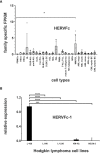Identification of Differentially Expressed Human Endogenous Retrovirus Families in Human Leukemia and Lymphoma Cell Lines and Stem Cells
- PMID: 33996550
- PMCID: PMC8117144
- DOI: 10.3389/fonc.2021.637981
Identification of Differentially Expressed Human Endogenous Retrovirus Families in Human Leukemia and Lymphoma Cell Lines and Stem Cells
Abstract
Endogenous retroviruses (ERVs) are becoming more and more relevant in cancer research and might be potential targets. The oncogenic potential of human ERVs (HERVs) has been recognized and includes immunosuppression, cell fusion, antigenicity of viral proteins, and regulation of neighboring genes. To decipher the role of HERVs in human cancers, we used a bioinformatics approach and analyzed RNA sequencing data from the LL-100 panel, covering 22 entities of hematopoietic neoplasias including T cell, B cell and myeloid malignancies. We compared HERV expression in this panel with hematopoietic stem cells (HSCs), embryonic stem cells (ESCs) and normal blood cells. RNA sequencing data were mapped against a comprehensive synthetic viral metagenome with 116 HERV sequences from 14 different HERV families. Of these, 13 HERV families and elements were differently expressed in malignant hematopoietic cells and stem cells. We found transcriptional upregulation of HERVE family in acute megakaryocytic and erythroid leukemia and of HERVFc family in multiple myeloma/plasma cell leukemia (PCL). The HERVFc member HERVFc-1 was found transcriptionally active in the multiple myeloma cell line OPM-2 and also in the Hodgkin lymphoma cell line L-428. The expression of HERVFc-1 in L-428 cells was validated by qRT-PCR. We also confirm transcriptional downregulation of ERV3 in acute megakaryocytic and erythroid leukemia, and HERVK in acute monocytic and myelocytic leukemia and a depression of HERVF in all malignant entities. Most of the higher expressed HERV families could be detected in stem cells including HERVK (HML-2), HERV-like, HERVV, HERVT, ERV9, HERVW, HERVF, HERVMER, ERV3, HERVH and HERVPABLB.
Keywords: LL-100 panel; RNA sequencing; embryonic stem cells (ESCs); gene expression; hematopoietic stem cells (HSCs); human endogenous retroviruses (HERVs); leukemia; lymphoma.
Copyright © 2021 Engel, Wieland, Krüger, Volkmer, Cynis, Emmer and Staege.
Conflict of interest statement
The authors declare that the research was conducted in the absence of any commercial or financial relationships that could be construed as a potential conflict of interest.
Figures





Similar articles
-
HIV-1 Infection of Primary CD4+ T Cells Regulates the Expression of Specific Human Endogenous Retrovirus HERV-K (HML-2) Elements.J Virol. 2017 Dec 14;92(1):e01507-17. doi: 10.1128/JVI.01507-17. Print 2018 Jan 1. J Virol. 2017. PMID: 29046457 Free PMC article.
-
Higher Expression of Human Endogenous Retrovirus-K was Observed in Peripheral B Lymphocytes of Leukemia and Lymphoma Patients.AIDS Res Hum Retroviruses. 2024 Apr;40(4):268-279. doi: 10.1089/AID.2023.0037. Epub 2023 Dec 21. AIDS Res Hum Retroviruses. 2024. PMID: 38009220
-
Human endogenous retroviruses form a reservoir of T cell targets in hematological cancers.Nat Commun. 2020 Nov 9;11(1):5660. doi: 10.1038/s41467-020-19464-8. Nat Commun. 2020. PMID: 33168830 Free PMC article.
-
Human Endogenous Retroviruses Are Ancient Acquired Elements Still Shaping Innate Immune Responses.Front Immunol. 2018 Sep 10;9:2039. doi: 10.3389/fimmu.2018.02039. eCollection 2018. Front Immunol. 2018. PMID: 30250470 Free PMC article. Review.
-
Utility of next-generation RNA-sequencing in identifying chimeric transcription involving human endogenous retroviruses.APMIS. 2016 Jan-Feb;124(1-2):127-39. doi: 10.1111/apm.12477. APMIS. 2016. PMID: 26818267 Review.
Cited by
-
Metagenomic insights into the plasma virome of Brazilian patients with prostate cancer.Mol Cell Oncol. 2023 Mar 15;10(1):2188858. doi: 10.1080/23723556.2023.2188858. eCollection 2023. Mol Cell Oncol. 2023. PMID: 36950183 Free PMC article.
-
HERV-K np9 and HERV-R env: Two endogenous retrovirus products with potential Pathogenic roles in pediatric acute lymphoblastic leukemia.Int J Immunopathol Pharmacol. 2024 Jan-Dec;38:3946320241274255. doi: 10.1177/03946320241274255. Int J Immunopathol Pharmacol. 2024. PMID: 39122243 Free PMC article.
-
Expression signature of human endogenous retroviruses in chronic lymphocytic leukemia.Proc Natl Acad Sci U S A. 2023 Oct 31;120(44):e2307593120. doi: 10.1073/pnas.2307593120. Epub 2023 Oct 23. Proc Natl Acad Sci U S A. 2023. PMID: 37871223 Free PMC article.
-
Overexpression of Endogenous Retroviruses and Malignancy Markers in Neuroblastoma Cell Lines by Medium-Induced Microenvironmental Changes.Front Oncol. 2021 May 7;11:637522. doi: 10.3389/fonc.2021.637522. eCollection 2021. Front Oncol. 2021. PMID: 34026614 Free PMC article.
-
Transposable elements in normal and malignant hematopoiesis.Dis Model Mech. 2023 Aug 1;16(8):dmm050170. doi: 10.1242/dmm.050170. Epub 2023 Jul 28. Dis Model Mech. 2023. PMID: 37503739 Free PMC article.
References
LinkOut - more resources
Full Text Sources
Other Literature Sources

